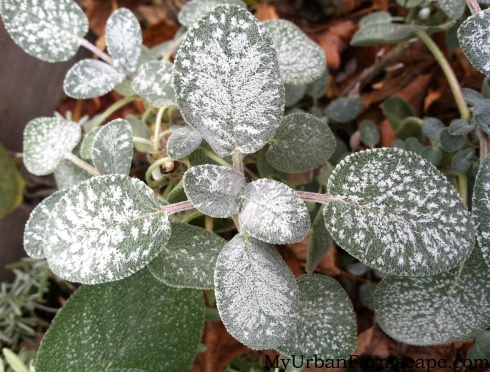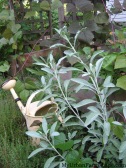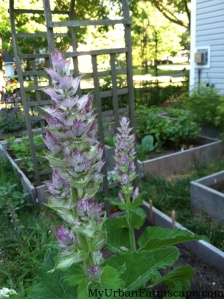After a hard frost last week I noticed how beautiful the icy crystals looked on my sage plant. As I continued to take pictures, I reminisced about its earthy flavor and how Thanksgiving wouldn’t be complete if this herb wasn’t included in the stuffing. I also use fresh sage leaves and incorporate into any Mediterranean dish. I am surprised at how it tastes so different from the dry powder my mom would use when I was younger and now, how it adds the right balance when prepared properly. I also love to make a rub of sage, salt and pepper. I use this on a pork roast.
Not only is sage, Salvia officinalis, used for culinary purposes, it also has some medicinal properties. Although I am not a practicing herbalist, or have I ever prepared an infusion of sage leaves in water to make a tea, or created any sage tinctures, I have read that sage is known for its effect in the reduction of perspiration. I have also read that extended or excessive use of sage can cause symptoms of poisoning! I found this information in a book by John Lust titled, The Herb Book. White sage, Salvia apiana, is a ceremonial herb used by Native Americans. This is the preferred herb for making smudge sticks. The leaves are smooth and the color is a lighter shade of grey.
I love growing sage, and it is the perfect herb for an urban farmscape. Why? Because culinary sages can be harvested throughout the season, can be dried and kept for long periods of time, and you can make useful gifts from your garden. They also look beautiful as there is nothing else that I can think of that has that grey color or texture. A member of the mint family, sage is easier to manage and shouldn’t spread like some of its cousins. For culinary use, I grow Salvia officinalis ‘Berggarten’ for its large rounded leaves, as well as Salvia officinalis ‘Extrakta’ which is higher in oils and a plant that I collect seeds from each year.
There is, however, a sage that I grew this summer that does not work well in an urban farmscape. That would be Clary Sage, Salvia sclarea. A biennial plant that will flower in its second year, growing small the first year, and exploding the following year both in size, flowers and seeds!
Clary has beautiful leaves, big like rhubarb but light green, bumpy and fuzzy. I loved it earlier in the season.
The flower heads hung down as they started to form, and as the flowers opened, they stood straight up as if they were shouting to the bees, “Here I am!” And boy oh boy, did the bees come! It flowered for the whole month of August, and I was able to collect many seeds.
So, here was the problem. I planted it next to the driveway, where every time my husband came home he would have to brush against it. He really didn’t like the smell of it. And if you touched it, the oils stayed on you and your clothes, thus allowing its fragrance to linger. I love the smell of sage, but many people don’t. I grew this sage to add to my collection. I need to find a different place in the garden where it will get a lot of sun. That will be tough. Clary sage is a medicinal herb, used mostly for its oils. I have no way of distilling oils from plants; I just really like the way it looks and the bees that it attracted to my garden.
So, here is my “sage advice”. Keep the culinary varieties in your urban farmscape, add some spice to your life and your food, maybe grow a little ceremonial sage to burn and cleanse the air, and save the Clary Sage for a sunny spot for a beautiful, eye-catching, dynamic bee plant….a little distance, but not too far from your walking path.






